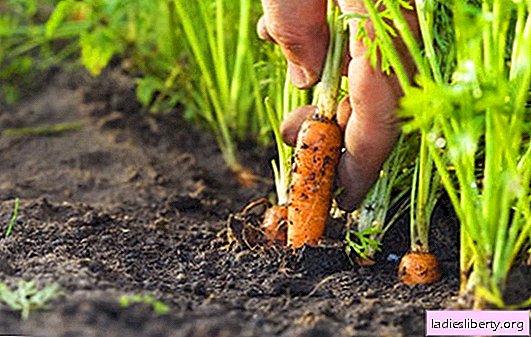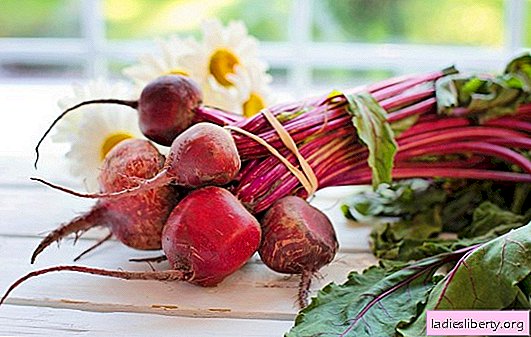
Carrots are a traditional root crop for our vegetable gardens, it seems that it’s impossible to learn about this vegetable, something new is impossible, but experienced owners have their own methods of cultivation that have been tried many times in practice.
After all, if in this case there are no difficulties, then for what reason does one carrot grow even and large, and the other, despite a lot of effort, it grows shallow, ugly and crooked.

Growing carrots. Selection of planting material, seeds
Many varieties make it easy to choose the appropriate option for obtaining the spring harvest, so for under-winter sowing.
Varieties with high yield:
• Flacquet;
• Queen of Autumn;
• Vitamin;
• Nantes;
• Tushon;
• Alenka.
Flakke - late-ripening variety, the crop can be harvested at the age of plants 100-120 days. The size of the root up to 30 cm, weight about 150-170 g.
Queen of Autumn - Late-ripening variety, excellent for storage in winter, the crop can be harvested at the age of 125-135 days. The size of the root to 20 cm, weight about 160 g
Vitamin - mid-season variety, contains a lot of carotene, the crop is harvested at the age of 110-120 days. The size of the root to 15 cm, weight about 150 g.
Nantes - mid-season variety, ripens completely in 85-90 days. Root crops 16 cm long, reach weight to 165 g
Tushon - early-ripening variety, used for cooking 60 days after germination. The size of root crops is 20 cm, weight reaches 150 g.
Alenka - early variety, ready to use after 50 days. Root crops weight up to 145 g, weight 12-15 cm.
Growing carrots: sowing (timing, dressing, shelter, temperature, soil, etc.)
Carrots must be sown in a bright place, roots growing in the shade grow small and taste worse. For this reason, for this culture, it is necessary to select a site that has been lit by the sun all day.

we sow carrots in ribbons
It is necessary to take into account the rules of crop rotation - the sequence of placement of crops for several seasons in one area.
Carrots should not be sown in the garden, where they were grown before:
• Celery;
• Pasternak;
• Dill;
• Parsley.
This root grows well after:
• Cabbage;
• Potatoes;
• garlic;
• Luke;
• Cucumbers;
• Tomatoes.
When is it best to sow carrots
Sowing at the right time for this crop is of great importance, it directly affects the yield. The term of ripening of root crops of different varieties varies in a large interval. Additionally, you need to take into account the desired time of receipt of vegetable products.
The planting dates also depend on the selected variety, for example, in the middle of April, early ripening varieties are sown, middle-ripening plants are sown almost until the end of May, and carrots can be planted for winter consumption until mid-June.
Growing carrots for "beam products" is done by sowing early varieties, early in the spring or before the onset of frost. Of course, autumn sowing is not possible in all regions, in frosty winters the seeds may die. For this reason, it is advisable to sow carrots in the early spring in the northern areas, immediately after warming up the soil.
Seed preparation before sowing allows you to immediately remove substandard seeds and speed up the emergence of seedlings. This operation does not require much effort. First, you need to fill the seeds with slightly heated water, after 10 hours have passed, the quality seeds will sink to the bottom. Seeds for the rapid emergence of seedlings sprinkled on a wet piece of tissue and so hold for several days, at a temperature of 20-24 degrees. So, the seeds in 3-4 days will release the roots.
Before planting the root crop, prepare and water the grooves 1.5-2 cm deep. Between rows, take a distance of 15 cm, place seeds in the groove with an interval of 2 cm.
Spring sowing
Early in the spring, seeds prepared in advance are sown in narrow grooves located after 10 cm. They are watered with warm water, powdered with ash or chalk and carefully covered with soil.
Attention! It makes no sense to sow carrots thickly; subsequently, only healthy and strong specimens will have to be broken through crops.
Planting with paper tape will allow you to sow the seeds in even rows. In winter, sticking seeds with glue is applied to paper tape. In the spring, you only need to spread the ribbon along the furrow and sprinkle it with soil. A joint planting of carrots with onions is used by many gardeners. Thus, you can get both high-quality onions and healthy roots. This culture does not germinate for a long time - the first entrances can sometimes be noticed only after a month.
With the onset of heat, weeds begin to actively develop; for this reason, many gardeners sow radishes, lettuce or spinach with carrot seeds, so you can weed the space between the rows after the lighthouse culture rises.
Sub-winter sowing
The climate of our country is unpredictable - unexpected, sharp cold snaps, thaw. For this reason, it is difficult to decide exactly when to sow carrots in late autumn. It is necessary to guess such a moment so that the carrots do not sprout to steady frosts, otherwise the sprouts will die. It is desirable to sow this culture on frozen ground, increasing the number of seeds by 20%.
When podzimny sowing it is not necessary to pre-prepare the seeds - soak and germinate, dry ones will not germinate too early.
Growing carrots: care, feeding
To get a visually appealing and tasty carrot, you need to take good care of the soil. It should be loose, the crust on the surface of the bed and compaction of the soil becomes the cause of the curvature of the carrot, the root crop will be large, but crooked and divided into several parts. Weeds growing alongside have a negative effect on the growth of carrots, they must be destroyed immediately. The first time we can see a garden bed, it will be necessary even before the appearance of sprouts.

Sown densely carrots grow small size, thinning crops should be immediately after the formation of these leaves. Plants should be at a distance of 3 cm. If the planting was carried out according to a certain pattern, then it is not necessary to break through it.
Growing carrots: watering and fertilizer
High-quality carrots grow only with stable watering. Lack of moisture - the main thing that leads to lethargy and bitterness of carrots. It is important to water the plants in the required quantity at any stage of their development. It is necessary to soak the soil in such a way that it becomes wet by 30 cm.
Carrots for the summer must be fed twice, 3-4 weeks after the appearance of seedlings, and again, two months later. Fertilize better in solution, per 10 l of water is one of these fertilizers:
1. 15 g of superphosphate and urea, and 20 g of potassium nitrate are added to the solution;
2. Paul one-liter jar of wood ash;
3. 25 g nitrophoska.
Harvesting carrots
For a gardener to clean grown roots - the most troublesome, but, without doubt, a very pleasant job. Basically, this operation is performed in the autumn, before the first frost. For example, late-ripening cabbage will be better kept if it is slightly picked up by the first weak frost (1-3 degrees). A carrot must begin to clean long before this time, most often in mid-September - immediately after harvesting potatoes.
Some gardeners for obtaining early products use podzymny sowing carrots or sowing early varieties in spring to get sweet young root vegetables in the second decade of summer. Of course, they are absolutely not suitable for storage in the winter. If the early carrot is not removed on time, it is most often begins to crack in the garden, loses its taste.
Mid-season carrots It should grow about 80-110 days, that it’s time to clean it, says the death of the lower leaves, you should not keep such varieties on the garden, the taste of the root crop will become worse and the flesh will become loose. Some gardeners mistakenly think that for full ripeness, the entire tops of carrots should turn yellow and yellow, this suggests not that the plants are ready for harvesting, but rather that they are sick.
Late carrot (growing season over 110 days), cleaned in the fall in mid-September, but only on a dry day, there should be no rain. If you hold it until the first frost, then the crop is sick with gray rot and so during storage you can lose all the roots. But it is impossible to hurry with the harvest of late-ripe carrots, temperature drops during storage will adversely affect the results. The last month before the start of harvesting carrots, it is not necessary to be watered at all, so that the roots will not begin to crack or not to provoke their growth.
Crop storage
In the cellar is placed on the surface of the floor boards, on top of them it is desirable put wormwoodas a "scarecrow" for rodents. Or you can lay the crop in boxes, pre-dried in the sun. Many store roots, sprinkling them with layers of sand.
Growing carrots: the main pests and ways to combat them
The main enemy of carrots - carrot fly, it can be detected by twisted leaves. Against this pest are protected, properly caring for carrots.
The fly breeds on very wet, overgrown with weeds and thickened crops. You can destroy the pest with the help of such compounds as: Actellic, Intavir, etc. During growth and after harvest, crops are affected by various rot.
Some of them cause a decrease in the taste of carrots (the root crop begins to taste bitter), others destroy the crop itself completely.
Dry rot
This disease is caused by a fungus, the plants become ill at the end of the growing season. Brown spots appear on the petioles and leaves. After that, as the disease progresses, it affects the root vegetable. The most active spread of fungus occurs during storage of root crops.
They begin to rot from the top, then on the surface gradually become shallow brown grooves with black fungus spores. If the temperature during storage is less than 10 degrees, then dry rot spreads slowly. When the temperature rises, the fungus develops faster, which causes the death of the entire carrot crop. Spores of the disease remain alive on the surface of the store for a long time.
Ways of struggle: collecting residues of plants, filling the soil with potash-phosphate fertilizer before planting.
White rot
The disease manifests itself as a result of the development of the fungus, can infect almost all cultures. When storing carrots, it forms wet rot and soft spots, at this time it is difficult to notice a defeat, and the roots hardly change their color. Over time, the soft areas are covered with a light patina, then a crust with black dots is formed. The disease infects the soil, its pathogen penetrates the soil with fresh manure.
Ways of struggle: spraying plants with copper-containing compounds, fertilizing crops with potash fertilizer, processing the storage with sulfur.
Gray rot
The disease, in the form of wet rot on the surface of the root, it becomes soft, and after a time it soaks and becomes dark. After that, in these areas a lot of raid is formed, gray. This disease causes large crop losses.
Ways of struggle: maintaining the temperature in the storage of about 2 degrees of heat, processing 1% Bordeaux liquid, fertilizing crops with fertilizers containing nitrogen.

carrot fly larvae
Carrot fly
This pest appears from the pupae in the middle of spring. A sign of the appearance of the pest is a bronze tint visible on the surface of the leaves. After a short time the plant withers and dies. If the seedlings were thinned late, the pest lays eggs in the ground. Over time, the larvae, which feed on root vegetables, are born from them. Such carrots are not suitable for use, they become bitter.
Ways of struggle: plowing the soil, weeding crops, processing such chemical compounds.
Carrot listobloshka
The insect is small in size, it has jumping legs the same as that of a flea. The female of the pest lays eggs on the vegetative mass, from which the larvae hatch, they suck the juice from the plants. As a result, the leaves dry after a short time.
Ways of struggle: sprinkle with a solution of soap or use for this infusion of tobacco.











